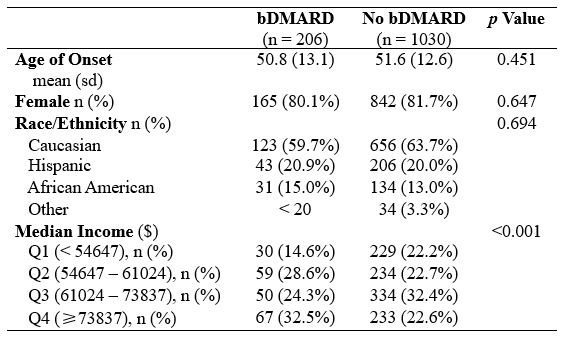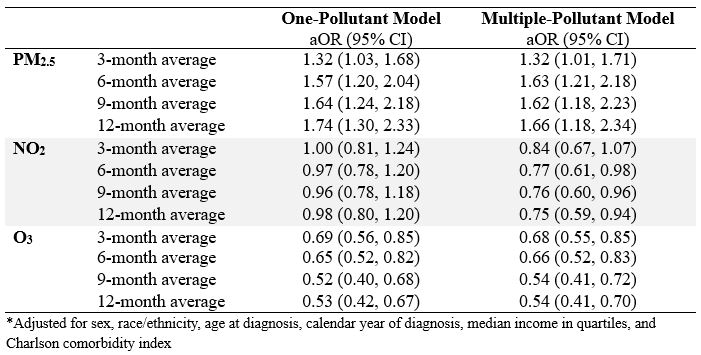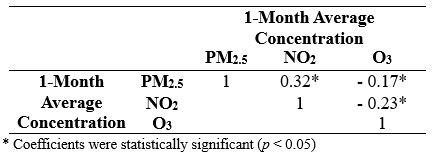Session Information
Session Type: Poster Session B
Session Time: 10:30AM-12:30PM
Background/Purpose: Ambient air pollution is a mixture of solid particles and gaseous pollutants derived from fossil fuel combustion and vehicle exhaust. Previous research has linked ambient air pollution with the onset of autoimmune diseases. This study aims to investigate the relationship between air pollution exposure and the initiation of bDMARDs in patients newly diagnosed with rheumatoid arthritis (RA).
Methods: Data was obtained from NIH All of Us Research Program (v7). RA patients were identified by at least 3 inpatient or outpatient visits with ICD-9, ICD-10 or SNOMED codes of RA in the EHR. Participants who received RA diagnosis between January 1, 2008 and December 31, 2015 were included in this study. Cases were defined as RA patients who received bDMARDs including etanercept, adalimumab, infliximab, golimumab, certolizumab, abatacept, and tocilizumab within 1 year of RA diagnosis. For each case, 5 controls were matched based on sex, age of RA diagnosis, race/ethnicity, and disease duration. Ambient air pollution data for PM2.5, NO2 and O3 were sourced from NASA’s Socioeconomic Data and Applications Center (SEDAC)1-3. Exposure to air pollutants was estimated based on the participants’ 3-digit zip code at enrollment. To assess the potential impact of pollution over time, we calculated averages for 3-month, 6-month, 9-month, and 12-month periods prior to bDMARD initiation. Conditional logistic regression was conducted to evaluate the odds of bDMARD initiation in relation to per interquartile range (IQR) increase in air pollutant concentrations. To address possible correlations among air pollutants, we calculated Pearson correlation coefficients (r) for pollutant pairs.
Results: We identified 206 cases and 1030 controls (Table 1). The average PM2.5, NO2 and O3 concentrations during the month of bDMARD initiation were 8.91 ± 3.34 µg/m3, 20.69 ± 10.22 ppb and 37.32 ± 8.97 ppb, respectively. We found increased odds of bDMARD initiation per IQR increase in PM2.5 concentrations, with adjusted odds ratios (aORs) of 1.32 (95% CI 1.01 – 1.71) for the 3-month average, 1.63 (95% CI 1.21 – 2.18) for the 6-month average, 1.62 (95% CI 1.18 – 2.23) for the 9-month average, and 1.66 (95% CI 1.18 – 2.34) for the 12-month average. We also observed a negative relationship between O3 concentrations and bDMARD initiation, with aORs of 0.68 (95% CI 0.55 – 0.85) for the 3-month average, 0.66 (95% CI 0.52 – 0.83) for the 6-month average, 0.54 (95% CI 0.41 – 0.72) for the 9-month average, and 0.54 (95% CI 0.41 – 0.70) for the 12-month average. No association was found between NO2 exposure and bDMARDs initiation (Table 2). There was a modest positive correlation between PM2.5 and NO2 (r = 0.32) and weak negative correlations between PM2.5 and O3 (r = -0.17), as well as NO2 and O3 (r = -0.23) (Table 3).
Conclusion: Our study suggests that higher PM2.5 levels are associated with increased bDMARD initiation in newly diagnosed RA patients, while higher O3 levels are linked to decreased initiation. The associations were consistent across various exposure periods. Further studies on larger cohorts are needed to confirm the results.
Reference: 1. Di, Environ Int. 2019; 2. Di, Environ Sci Technol. 2020; 3. Requia, Environ Sci Technol. 2020
To cite this abstract in AMA style:
Zheng J, Barjaktarovic N, lu L. Ambient Air Pollution and Initiation of bDMARDs in Newly Diagnosed Rheumatoid Arthritis: A Nested Case-Control Study of NIH All of Us Cohort [abstract]. Arthritis Rheumatol. 2024; 76 (suppl 9). https://acrabstracts.org/abstract/ambient-air-pollution-and-initiation-of-bdmards-in-newly-diagnosed-rheumatoid-arthritis-a-nested-case-control-study-of-nih-all-of-us-cohort/. Accessed .« Back to ACR Convergence 2024
ACR Meeting Abstracts - https://acrabstracts.org/abstract/ambient-air-pollution-and-initiation-of-bdmards-in-newly-diagnosed-rheumatoid-arthritis-a-nested-case-control-study-of-nih-all-of-us-cohort/



